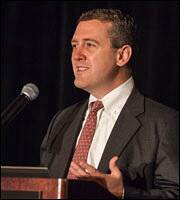Courtesy of Pam Martens.
Since the depths of the financial crisis in 2008 and 2009, James Bullard, President of the Federal Reserve Bank of St. Louis, has been talking up a storm and moving markets. On multiple occasions, however, after Bullard has talked up tightening, he’s had to backtrack and urge easier monetary policy as the U.S. economy wilted back into subpar GDP growth.
Yesterday, at a presentation to the annual Hyman P. Minsky “Conference on the State of the U.S. and World Economies,” Bullard made a case for the Fed raising interest rates sooner than the markets expect. Among the key points presented in his slide presentation were that “U.S. labor markets have been improving at a rapid pace over the last year,” and “U.S. GDP growth prospects remain relatively robust.”
Dow Jones’ MarketWatch called Bullard “a leading hawk on the Federal Reserve” in its report yesterday on his talk. But Bullard is actually an enigma at the Fed, vacillating between dove and hawk on a regular basis depending on what the data is showing about the recovery.
In the September/October 2010 edition of the Federal Reserve Bank of St. Louis Review, Bullard penned a paper titled Seven Faces of ‘The Peril’. The paper argued that the U.S. economy could be heading for a “Japanese-style deflationary outcome” within the next several years and urged more quantitative easing, a decidedly dovish position. Bullard wrote:
“The global economy continues to recover from the very sharp recession of 2008 and 2009. During this recovery, the U.S. economy is susceptible to negative shocks that may dampen inflation expectations. This could push the economy into an unintended, low nominal interest rate steady state. Escape from such an outcome is problematic. Of course, we can hope that we do not encounter such shocks and that further recovery turns out to be robust—but hope is not a strategy. The United States is closer to a Japanese-style outcome today than at any time in recent history.”
…




